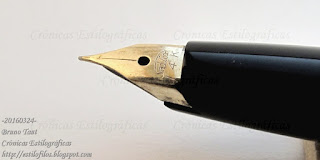The following pocket pen is one of the last models made by Swan on those 1970s:
It is mostly made of plastic, including the central ring coupling section and barrel together. This is a clear sign of the cheap construction of this pen. Another is the fact that the gold plated steel nib was outsourced from the company Teikoku Kinpen, as is clearly stated by the engraved JIS number 3253. The pen must be inked using Platinum cartridges, as was often the case of lesser brands after the introduction of cartridges in Japan. No modern ink converter fits in the pen.

The pen, disassembled. Note the plastic central ring. The nib slides off the feed. Contrary to the case of most pocket pens, nib and feed are friction fit in the section.
This model is green with golden cap. It was also made in black, with black cap and golden accents.
These are its dimensions:
Length closed: 116 mm
Length open: 97 mm
Length posted: 145 mm
Diameter: 12.0 mm
Weight: 9.0 g (dry, no cartridge)
Ink deposit: 1.1 ml (Platinum cartridge)
All in all, this is a mostly boring and irrelevant pen, save for the detail of being one of the latest models made by Swan Mannenhitsu Seisakushô, indeed a very important actor in the history of Japanese fountain pens.
Sailor Magna – Tomiya Original Ink (Sailor)
Bruno Taut
Nakano, March 24th, 2016
etiquetas: Swan, Platinum, Pilot
Bruno Taut
Nakano, March 24th, 2016
etiquetas: Swan, Platinum, Pilot























